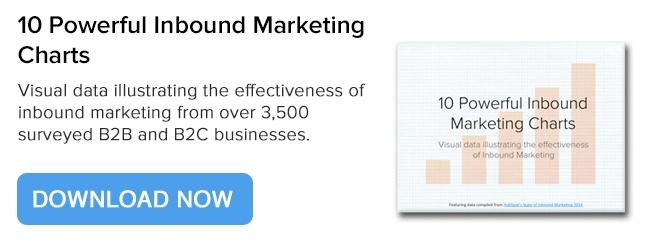Content As The Foundation Of Your Inbound Marketing Strategy
By Jaco Grobbelaar on Tue, Jun 21, 2016 @ 10:56 PM


The Egyptians knew a thing or two about buildings. Especially BIG buildings. And one of the essential things is that anything that is built to last must have a good foundation.
And this is just as true for your inbound marketing efforts as it is for, well - pyramids.
Building a Content Foundation for Your Inbound Marketing
Recently in an article about what factors drive Google search results, Search Engine Land's News Editor Barry Schwartz wrote:
We knew last year that RankBrain was said by Google to be the third most important ranking factor, but Google refused to say what the first two were. [I]n a Q&A with Google, Andrey Lipattsev, a Search Quality Senior Strategist at Google, said the other two factors were links and content:
"I can tell you what they are. It is content. And it’s links pointing to your site."
He wouldn’t say which was more important, so the top three list now looks like this:
1 & 2: Links & Content
3: RankBrainOf course, Google looks at many other factors... But these are the overall top three, officially confirmed by Google itself."
What this means for business owners and managers tasked with marketing the businesses they work for is that, aside from Google's algorithm tools, what really matters is links and content. The good news that, while you can only guess at much of what goes on inside the search engines themselves, you can definitely optimize your content.
Ranking "Number One" Really Isn't the Goal - Getting More Views Is
There a number of factors that determine how well your website will rank in search results. But if you get your content right, then you’ve created a solid foundation to support all of your other SEO efforts.
Here are the four foundational elements for creating and optimizing great content to drive your inbound marketing and search results:
1. Quality of Your Content
Are you creating quality content? If you’re selling something, do you go beyond the same information that can be found on all of your competitor's sites?
Do you provide compelling reasons to encourage visitors to spend more than a few seconds reading your pages?
Does your content provide value? Something that is unique, different, useful - and that they probably won’t find anywhere else?
Here's how Google says it:
The key to creating a great website is to create the best possible experience for your audience with original and high quality content. If people find your site useful and unique, they may come back again or link to your content on their own websites. This can help attract more people to your site over time.
Google is looking primarily for relevance, not keywords. Quality content is the cornerstone upon which nearly all other factors depend.
2. Your Keyword Research
Perhaps the most important SEO factor after creating good content is good keyword research. There are a number of tools that can use to determine what people may typing into search engines when searching for your type of content.
The 'key' is to create content using those actual search terms people are using, so you can produce content that will, in essence, “answer” their query.
For example, a page about “landscaping” might use industry terms to describe landscaping services. A search engine might skip or not rank that page highly if people are actually searching for “improving home value with landscaping”.
Your content needs to answer the questions or solve the problems real users are typing when searching.
3. Use Your Keywords
After effective keyword research you need to use those words in your content. If you want your website or pages to be found for particular words, it’s a good idea to actually use those words in your written content.
And don't simply cram your keywords everywhere. Instead, simply repeat each word you want to be found for at least five times in a piece, or try to maintain a keyword density of close to 2.5%.
Just use good writing skills. Take into account the words you want a page to be found for and then use them naturally on the page.
4. Fresh Content
Google, Bing and Yahoo love new content. This is what is meant by "fresh" content.
But how do you determine how much and how often? Google has a function called “Query Deserved Freshness (QDF)”. According to SearchEngineLand.com,
If there’s a search that is suddenly very popular versus its normal activity, Google will apply QDF to that term and look to see if there’s any fresh content on that topic. If there is, that new or fresh content is given a boost in search results.
The best way to think about this is a term like ‘hurricane’. If there’s no active hurricane, then the search results will likely contain listings to government and reference sites. But if there’s an active hurricane, results will change and may reflect stories, news and information about the active hurricane.
So when you have plenty of fresh content, on the right topic when QDF is applied, you may see a jump in results for days or weeks. After that, however, your page may drop back down again in search results.
But if your content is high quality, relevant and - better yet - evergreen, then it will have "freshness juice" for much longer.
Your company can take advantage of this freshness boost by producing relevant content that's in line with the real-time issues in your industry.
Inbound Marketing and Your Great Content
A number of terms are often used to describe inbound marketing, such as "content marketing", "digital marketing", "social media marketing", and so on. We prefer the term "Inbound Marketing".
According to Hubspot:
"Inbound marketing focuses on creating quality content that pulls people toward your company and product, where they naturally want to be. By aligning the content you publish with your customer’s interests, you naturally attract inbound traffic that you can then convert, close, and delight over time."
This content typically takes the form of blog posts aligned with periodic ebooks and even email campaigns. The end result is a cost-effective, multi-faceted marketing strategy that not only attracts ideal leads, but deepens the relationships with customers and clients, while positioning a company as an influencer and thought leader in it's industry.
Regardless of which term you prefer to use, the approach of inbound marketing holds great promise for your business.
But achieving these objectives with your content marketing strategy takes time. It won't happen with a few blog posts or great ebook. People will need to consume your content for a while before they contact you. Yet, without your content compelling them to contact you, your goals may never be met.
Get your Free Complimentary Inbound Marketing Session to help you make an informed decision or call BroadVision Marketing at 707-799-1238.
You May Also Like
These Related Stories

Answering Your Customer's Questions With Your Content Is Critical For Local SEO

What Matters Most In Ranking For Local SEO

.png?width=302&height=75&name=BVM%20Logo%20-%20transparent%20(1).png)


No Comments Yet
Let us know what you think